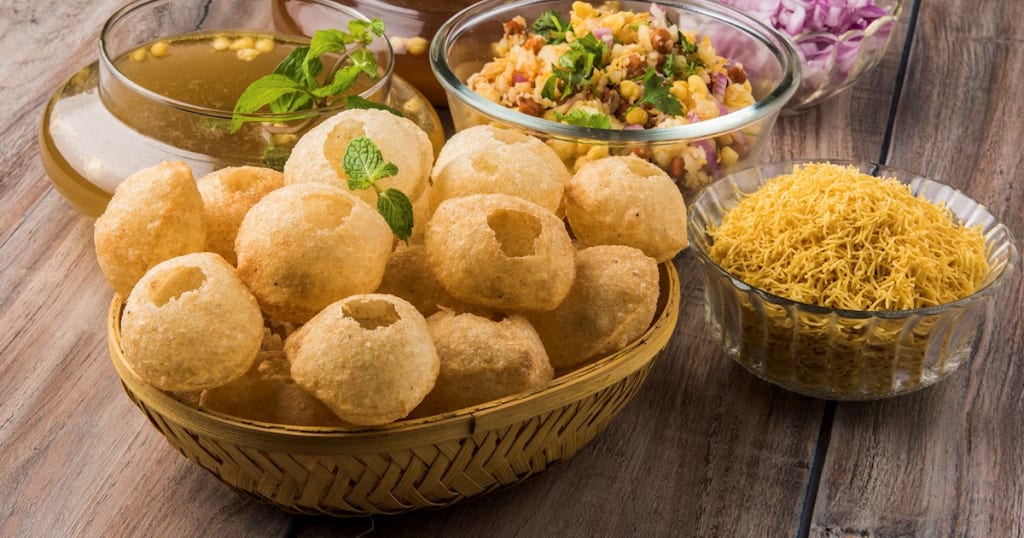The History and Evolution of India's Beloved Street Snack: Pani Puri
"From a Simple Snack to a Cultural Icon: Tracing the Origins and Transformations of Pani Puri"

1.Introduction
Pani Puri, also known as Golgappa, is a popular street snack in India, which has been enjoyed for generations. The origin of Pani Puri is not clear, but it is believed to have originated in the Northern regions of India, particularly in Uttar Pradesh and Bihar, during the 19th century.
Initially, Pani Puri was a simple snack consisting of a fried hollow ball of flour (puri), filled with boiled chickpeas, mashed potatoes, and chutney. The chutney was usually made of tamarind, coriander, and mint leaves, and served with spicy water (pani).
Over time, the recipe for Pani Puri has evolved, and today, there are many variations of this popular snack. In some parts of India, the puris are filled with sprouts, boiled moong dal, or even sweetened chutneys. The pani is also made with different ingredients, such as lemon juice, jaljeera powder, or even coconut water.
Pani Puri has become a beloved street snack across India and is commonly sold by street vendors, who often have their unique recipes and variations. It is a ubiquitous snack in Indian households, and families often gather around the kitchen to make and enjoy this delicacy together.
Today, Pani Puri has become a staple of Indian street food, and it has gained popularity worldwide, with restaurants and food trucks serving this delicious snack in many parts of the world. The history and evolution of Pani Puri show how this simple snack has become an essential part of Indian cuisine and a beloved street food worldwide.
2.Origin of Pani Puri
The origin of Pani Puri is not entirely clear, but it is believed to have originated in the Northern regions of India, particularly in Uttar Pradesh and Bihar, during the 19th century.
The early versions of Pani Puri were a simple snack consisting of a fried hollow ball of flour (puri), filled with boiled chickpeas, mashed potatoes, and chutney. The chutney was usually made of tamarind, coriander, and mint leaves, and served with spicy water (pani).
As Pani Puri became popular, it began to evolve, with different regions of India developing their variations. Today, there are many variations of this popular snack, with different types of puris, fillings, and pani being used.
Although the exact origin of Pani Puri is unclear, it has become an essential part of Indian street food culture and a beloved snack for people all over India. It is often sold by street vendors, who have their unique recipes and variations, and families often gather around the kitchen to make and enjoy this delicacy together.
3. The Evolution of Pani Puri
Pani Puri has undergone a significant evolution since its origin in the 19th century. Over time, the recipe for Pani Puri has evolved, and today, there are many variations of this popular snack. Here are some ways in which Pani Puri has evolved over time:
1. Types of Puris: Originally, Pani Puri was made with a simple hollow ball of flour (puri). However, over time, different types of puris have been used, such as whole wheat, semolina, or even beetroot puris.
2. Filling Ingredients: In the early versions of Pani Puri, the filling usually consisted of boiled chickpeas, mashed potatoes, and chutney. However, today, there are many variations of the filling, such as sprouts, boiled moong dal, or even sweetened chutneys.
3. Types of Pani (spiced water): Originally, the pani used for Pani Puri was made with tamarind, coriander, and mint leaves. However, today, different types of pani are used, such as lemon juice, jaljeera powder, or even coconut water.
4. Regional Variations: Different regions of India have their variations of Pani Puri, with unique recipes and variations. For example, in Mumbai, the pani is usually spicier, while in Kolkata, the pani is sweeter.
5. Fusion Variations: Pani Puri has also influenced fusion cuisine, with chefs creating unique variations of Pani Puri by incorporating ingredients from other cuisines, such as Mexican or Italian.
The evolution of Pani Puri shows how this simple snack has become an essential part of Indian cuisine and street food culture, with unique variations being created in different regions and even inspiring fusion cuisine.
4. Pani Puri and Indian Culture
Pani Puri is not just a popular street food snack in India, but it is also an essential part of Indian culture. Here are some ways in which Pani Puri is an important part of Indian culture:
1. Street Food Culture: Pani Puri is a quintessential street food snack in India and is sold by street vendors in every corner of the country. Eating Pani Puri from street vendors is not just about satisfying hunger, but it is also a social experience where people gather around the vendor, share their love for the snack, and chat with each other.
2. Family Gatherings: Pani Puri is also a popular snack for family gatherings in India. Families often gather in the kitchen to make and enjoy Pani Puri together, sharing recipes, and passing down traditions from generation to generation.
3. Festivals and Celebrations: Pani Puri is also an essential part of many Indian festivals and celebrations. For example, during the festival of Holi, Pani Puri is a popular snack, and people often make and serve it to guests.
4. Regional Identity: Pani Puri has different variations in different regions of India, which reflects the regional identity and cultural diversity of the country. For example, in Mumbai, Pani Puri is called "Gol Gappa," and the pani is usually spicier than other regions.
5. Symbol of Unity: Pani Puri is also a symbol of unity in India. People from different socio-economic backgrounds and religions can often be seen standing in line together to enjoy this beloved snack, breaking down cultural barriers and bringing people together.
Overall, Pani Puri has become an integral part of Indian culture, reflecting the diversity, unity, and social nature of the country.
5. Conclusion
In conclusion, Pani Puri is a popular street food snack in India that has a rich history and has evolved over time. Originating in Northern India in the 19th century, Pani Puri was a simple snack consisting of a fried hollow ball of flour filled with boiled chickpeas, mashed potatoes, and chutney. However, over time, Pani Puri has evolved with different types of puris, fillings, and pani being used, reflecting the diversity and regional identity of the country. Today, Pani Puri is not just a snack but an essential part of Indian culture, bringing people together and reflecting the social, cultural, and regional diversity of the country. With its rich history and evolution, Pani Puri has become an integral part of Indian street food culture and will continue to be a beloved snack for generations to come.





Comments
There are no comments for this story
Be the first to respond and start the conversation.